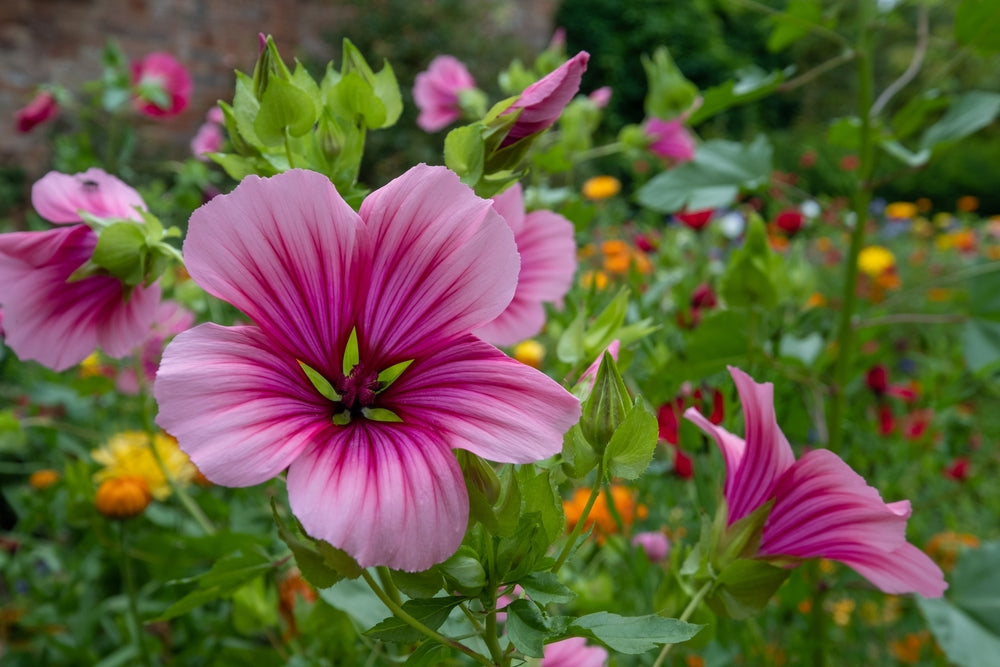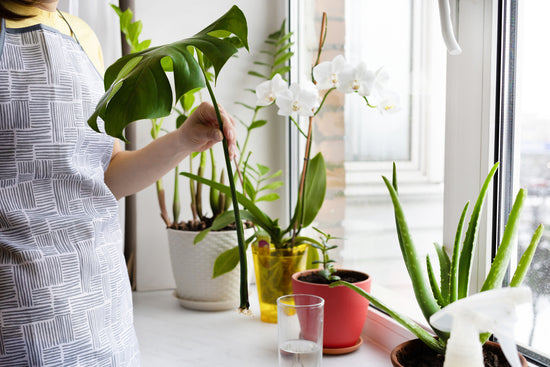Closely associated with the Hollyhock plant, Mallow plants - termed Malva sylvestris scientifically - are widely regarded for the ornamental value they add with their majestic flowers.
With blooms of a deep purple color, decorated with intricate, dark-colored veins, the Mallow plant is a wonderful addition to garden scapes and floral arrangements.
● Mallow Flowers: Origins and Symbolism

Mallow flowers, scientifically known as Malva, have a rich history dating back to ancient civilizations. Believed to have originated in Europe and Asia, various species of Mallow flowers are often found in different regions.
Symbolically, Mallow flowers have often been associated with love, protection, and healing. In ancient times, they were used in herbal remedies and even as offerings to deities.
Different types of Mallow plants and flowers symbolize different things. But to sum it up, these flowers are commonly associated with harmony, resilience, and adaptability along with love, healing, and protection.
● 7 Mallow Plant Types You Can Grow

There are several species of Mallow flowers, many of which have originated from different parts of the world. Wherever they may trace their roots back to, their ornamental value and the beauty that they add to spaces remain consistent.
These plants can be grown from flower seeds and with the right kind of care, they can bloom to produce the most wonderful, delicate flowers capable of enhancing your garden aesthetic.
Here are 7 varieties of Mallow plants and flowers that you can grow in your garden:
1. Chinese Mallow (Malva verticillata)
Native to China, Chinese mallow, also known as Cluster Mallow, has spread to other parts of Asia and beyond because of its majestic presence in places that it graces.
This Mallow variety features clusters of pink to lavender flowers and has been historically used in traditional Chinese medicine for its potential health benefits.
2. Marsh Mallow (Althaea Officinalis)
This variety of Mallow is said to be native to Europe, Western Asia, and North Africa, and is a perennial herb known for its medicinal properties.
With pale pink flowers and velvety leaves, Marsh Mallow is well-known for its mucilaginous roots, which have been historically used for soothing sore throats and some digestive issues.
3. Dwarf Mallow (Malva neglecta)
Dwarf mallow, also called Common Mallow, is native to Europe and Asia but has become widespread globally due to its alluring charm and memorable visuals.
This low-growing shrub-like plant blooms small lavender flowers and is often considered a weed in gardens. Despite its well-known reputation of being a weed, it has various culinary uses, and its leaves are edible.
4. Common Mallow (Malva sylvestris)

Widely distributed across Europe, Asia, and North Africa, Common Mallow is a wildflower commonly found in diverse habitats.
With its striking pink or purple flowers, Common Mallow is recognized by its webbed leaves and is often found in meadows, along roadsides, and in areas left undisturbed for long durations.
5. Tree Mallow (Lavatera maritima)
Native to the coastal regions of Europe, Tree Mallow is a shrub plant often found in coastal environments.
This species of Mallow plants features large, showy flowers in pink and purple hues. Its tolerance to salt spray makes it suitable for coastal gardens.
6. Musk Mallow (Malva moschata)
Native to Europe and Western Asia, Musk Mallow is a perennial herb valued for its ornamental qualities.
Known for their musky fragrance, these mallow plant varieties display pink or white flowers and are a favorite in cottage gardens. The plant attracts bees and butterflies and is cultivated for its seeds. The Musk Mallow seeds are then used in perfumes, replacing musk when needed. They also produce widely used essential oils.
7. Greater Musk Mallow (Lavatera x clementii)

A hybrid of Lavatera species, the Greater Musk Mallow is cultivated for its showy blooms and garden appeal. Native to southwestern, central, and eastern Europe and parts of Asia, this species of Mallow is beloved for its size and unending ornamental value.
Featuring large, trumpet-shaped flowers in shades of pink, this hybrid is often used in ornamental gardens and landscaping projects. It combines the best qualities of its parent species.
● Mallow Flowers: Uses and Benefits
1. Culinary Uses:
Mallow leaves are edible and are rich in vitamins and minerals, offering a mild, slightly tangy flavor. They can be added to salads, soups, or sautéed as nutritious greens to consume.
2. Mallow Plant Medicinal Uses:
Marsh Mallow, in particular, has been historically used for its mucilaginous roots, offering relief for sore throats, coughs, and digestive issues with its soothing properties.
Some mallow species possess anti-inflammatory properties, making them potentially beneficial for conditions like skin irritations.
3. Nutrient-Rich Mallow Seeds:
Mallow seeds are a good source of nutrients, including healthy fats, protein, and antioxidants. They can be consumed as part of a balanced diet. Some varieties like the Musk Mallow even produce seeds that are used in perfumes because of their fragrant qualities.
Buy Flower Seeds
4. Pollinators Adore Mallows:

Mallow flowers, especially Musk Mallow, attract bees and butterflies, contributing to pollination and the overall health of the ecosystem, maintaining a healthy biodiversity in the surrounding areas.
5. Ornamental Value:
Tree Mallow and Great Musk Mallow, with their showy blooms, add ornamental beauty to gardens and landscapes, enhancing visual appeal.
6. Traditional Medicine:
Chinese Mallow has been utilized in TCM (Traditional Chinese Medicine) for its potential health benefits, contributing to overall well-being and balance. Other Mallow flowers, notably Marsh Mallow, boast medicinal benefits with soothing properties. Historically used to alleviate sore throats and digestive issues, their anti-inflammatory nature offers relief. Mallow's healing potential extends to skin irritations, showcasing its versatility in traditional medicine.
7. Adaptability in Landscaping:
Many mallow species, including Lavatera, are drought-tolerant once established, making them suitable for xeriscaping and water-conscious gardening.
8. Cottage Garden Charm:
Musk Mallow's fragrant blooms and attractiveness to pollinators make it a charming addition to cottage gardens, fostering a delightful environment.
● Mallow Plant Care Tips

1. Sunlight and Soil:
Plant your Mallow seeds in well-draining soil with full sunlight exposure for optimal growth. Mallow plants, including the Lavatera plant variety, thrive in sunny locations.
2. Watering:
Provide regular watering, especially during dry periods. Once established, mallow plants are generally drought-tolerant, but consistent moisture promotes more growth.
3. Pruning:
Regular pruning encourages bushier growth and prolongs flowering. Deadhead spent flowers to encourage the growth of new blooms and to maintain an attractive appearance.
4. Fertilization:
Apply a balanced, all-purpose fertilizer during the growing season to support mallow plants' nutritional needs. During the dormant season, you can reduce or entirely eliminate fertilization.
5. Pest and Disease Management:
Monitor for pests such as aphids and caterpillars as they can regularly be found on Mallow plants. Treat infestations promptly with insecticidal soap or neem oil, and ensure good air circulation to prevent fungal issues.
6. Propagation:
Propagation of mallow plants can be done through seeds or cuttings. Collect seeds when flowers mature and sow them in spring. Take softwood cuttings in early summer for propagation.
7. Winter Care:

In colder climates, provide a layer of mulch around the base of the plant to protect roots during winter. Prune back dead or damaged growth in early spring.
8. Container Gardening:
Mallow varieties, particularly dwarf ones, can thrive in containers. Ensure the pots have drainage holes, and use well-draining soil, and water consistently.
Ensuring that your Mallow plants are getting the right kind of care and attention from you will allow you to grow a garden full of the most stunning blooms. For ease and convenience throughout the gardening process, you can also make use of all-purpose gardening brands like Ugaoo to have all your plant and plant care needs met at the same place.
Take your pick from the vast variety of Mallow plants and start your own garden blossoming with stunning flowers and booming biodiversity!










